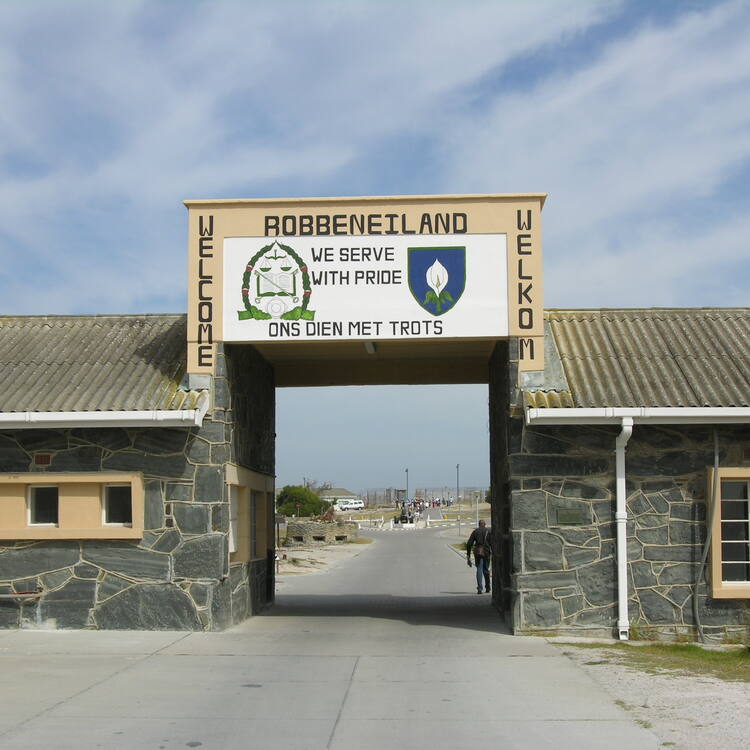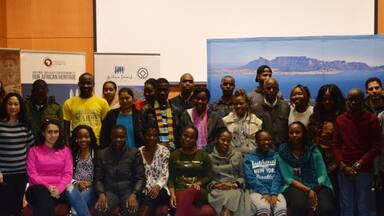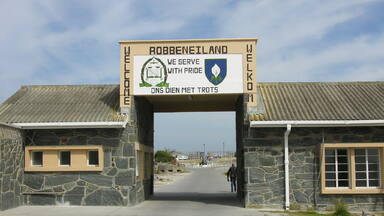Robben Island
Robben Island
Robben Island was used at various times between the 17th and 20th centuries as a prison, a hospital for socially unacceptable groups and a military base. Its buildings, particularly those of the late 20th century such as the maximum security prison for political prisoners, witness the triumph of democracy and freedom over oppression and racism.
Description is available under license CC-BY-SA IGO 3.0
Robben Island
Robben Island a été utilisée à différentes époques entre le XVIIe et le XXe siècle comme prison, hôpital pour les malades socialement indésirables et base militaire. Ses bâtiments, et en particulier ceux du XXe siècle, la prison à haute sécurité pour les prisonniers politiques, témoignent de l'oppression et du racisme qui régnaient avant le triomphe de la démocratie et de la liberté.
Description is available under license CC-BY-SA IGO 3.0
جزيرة روبن
تمّ استعمال جزيرة روبن خلال مراحل مختلفة بين القرنين السابع عشر والعشرين كسجن وكمستشفى للمرضى غير المرغوب بهم اجتماعياً وكقاعدة عسكرية. وتشهد المباني وبشكل خاص مباني القرن العشرين والسجن المشدّد الأمن الخاص بالسجناء السياسيين على الظلم والعنصرية اللذين سادا قبل انتصار الديمقراطية والحرية.
source: UNESCO/CPE
Description is available under license CC-BY-SA IGO 3.0
罗布恩岛
从17世纪到20世纪罗布恩岛曾有过不同的用途,它曾经是监狱、不受社会欢迎的人的医院和军事基地。这里的建筑,特别是那些在20世纪后期的建筑,如用来关押政治犯的监狱,见证了民主和自由战胜压迫和种族主义的过程。
source: UNESCO/CPE
Description is available under license CC-BY-SA IGO 3.0
Остров Роббен-Айленд
В период XVII-ХХ вв. Роббен-Айленд использовался как тюрьма, больница для обездоленных и как военная база. Его постройки, особенно те, что относятся к концу ХХ в., например, сверхсекретная тюрьма для политических заключенных, стали свидетелями победы демократии и свободы над угнетением и расизмом.
source: UNESCO/CPE
Description is available under license CC-BY-SA IGO 3.0
Robben Island
Robben Island fue utilizada en diferentes épocas, entre los siglos XVIII y XX, como prisión, base militar y hospital para grupos catalogados como socialmente indeseables. Los edificios del siglo XX, y más concretamente los de la cárcel de alta seguridad para presos políticos, constituyen un testimonio de la opresión y el racismo que imperaban antes del triunfo de la democracia y la libertad.
source: UNESCO/CPE
Description is available under license CC-BY-SA IGO 3.0
ロベン島
南アフリカ南部、西ケープ州、ケープタウンの沖合いに浮かぶ島。17世紀以来、刑務所、病院、基地など時代によってさまざまな用途があった。アパルトヘイト時代に主に黒人政治犯が収容されていた。そのなかにはネルソン・マンデラ氏も含まれる。1959年の開所から1991年最後の政治犯が釈放されるまでの32年間に延べ約3000人が獄につながれた。抑圧と人種差別主義に抵抗した民主主義と自由の勝利のもとに1996年に閉鎖され、現在は博物館となっている。南アフリカでは最初の文化遺産。source: NFUAJ
Robbeneiland
Robbeneiland werd op verschillende momenten tussen de 17e en de 20e eeuw gebruikt als gevangenis, als ziekenhuis voor maatschappelijk onaanvaardbare groepen en als militaire basis. De gebouwen – met name die van de late 20e eeuw, zoals de maximaal beveiligde gevangenis voor politieke gevangenen – getuigen van de overwinning van de democratie en de vrijheid op onderdrukking en racisme. Robbeneiland is bekend door de gevangenschap van Nelson Mandela. Hij werd hier ruim 20 jaar lang opgesloten. De laatste politieke gevangenen verlieten het eiland in 1991 en de gevangenis werd uiteindelijk in 1996 gesloten. Sindsdien is het een museum.
Source: unesco.nl
Outstanding Universal Value
Brief synthesis
Robben Island was used at various times between the 17th century and the 20th century as a prison, a hospital for socially unacceptable groups, and a military base. Its buildings, and in particular those of the late 20th century maximum security prison for political prisoners, testify to the way in which democracy and freedom triumphed over oppression and racism.
What survives from its episodic history are 17th century quarries, the tomb of Hadije Kramat who died in 1755, 19th century ‘village’ administrative buildings including a chapel and parsonage, small lighthouse, the lepers’ church, the only remains of a leper colony, derelict World War II military structures around the harbour and the stark and functional maximum security prison of the Apartheid period began in the 1960s.
The symbolic value of Robben Island lies in its somber history, as a prison and a hospital for unfortunates who were sequestered as being socially undesirable. This came to an end in the 1990s when the inhuman Apartheid regime was rejected by the South African people and the political prisoners who had been incarcerated on the Island received their freedom after many years.
Criterion (iii): The buildings of Robben Island bear eloquent witness to its sombre history.
Criterion (vi):Robben Island and its prison buildings symbolize the triumph of the human spirit, of freedom and of democracy over oppression.
Integrity
The remains on the island as a landscape reflect the history of the island since the 17th century and all the attributes that convey its value.
Little route maintenance had been carried out since The Department of Correctional Services abandoned the island, and many structures require repair and maintenance. A variety of marine and land-based natural, and man-induced, threats also exist due to the lack of clear controls, facilities and direction. With over 700 buildings and sites listed on the island database, those that are not occupied or used are vulnerable to decay.
A growth in visitor-numbers is also putting pressure on the island’s natural and built resources. Work has focused on capital works and infrastructure projects where funding has been easier to obtain compared to budgets for preventive maintenance activities. This imbalance in activities threatens the integrity of what remains.
Authenticity
Precisely because it has followed a historical trajectory that has involved several changes of use without conscious conservation efforts directed at preservation, the authenticity of the Island is total.
The evidence of layering reflects its history since the early 17th century and the events with which it is associated.
Protection and management requirements
In terms of the National Monuments Act of South Africa, the area was declared as a National Monument in 1996. Robben Island, and its buffer zone of one nautical mile, is legally protected as a National Heritage Site through the National Heritage Resources Act(No 25 of 1999); the World Heritage Convention Act (Act No 49 of 1999); the Cultural Institutions Act (Act No 119 of 1998); the National Environmental Management Act (Act No 107 of 1998); National Environmental Management: Biodiversity Act (Act No 10 of 2004); and the National Environmental Management: Protected Areas Act (Act No 57 of 2003). Protection in terms of the latter implies that mining or prospecting will be completely prohibited from taking place within the property or its buffer zone. Furthermore, any unsuitable development with a potential impact on the property will not be permitted by the Minister of Environmental Affairs and Tourism.
The management authority for the property rests with the Robben Island Museum Council with delegated authority for the day-to-day management and conservation matters residing with the Chief Executive Officer.
Progress has been made with the implementation of the Integrated Conservation management plan, specifically in relation to physical conservation and preventive conservation work, ongoing improvements in interpretation and visitor management, and better cooperation with the Department of Public Works. There is a need to improve the institutional/managerial aspects of the property in order to address the vulnerabilities of the built heritage. In particular there is a need to implement the recommendations of the June 2003 Status Quo report, undertaken by the Department of Public Works to assist in guiding future maintenance planning, budgeting and to establish a system to monitor progress. It included an inventory of most infrastructure and facilities, assessed their condition and recommended repairs.

 View photos from OUR PLACE the World Heritage collection
View photos from OUR PLACE the World Heritage collection






